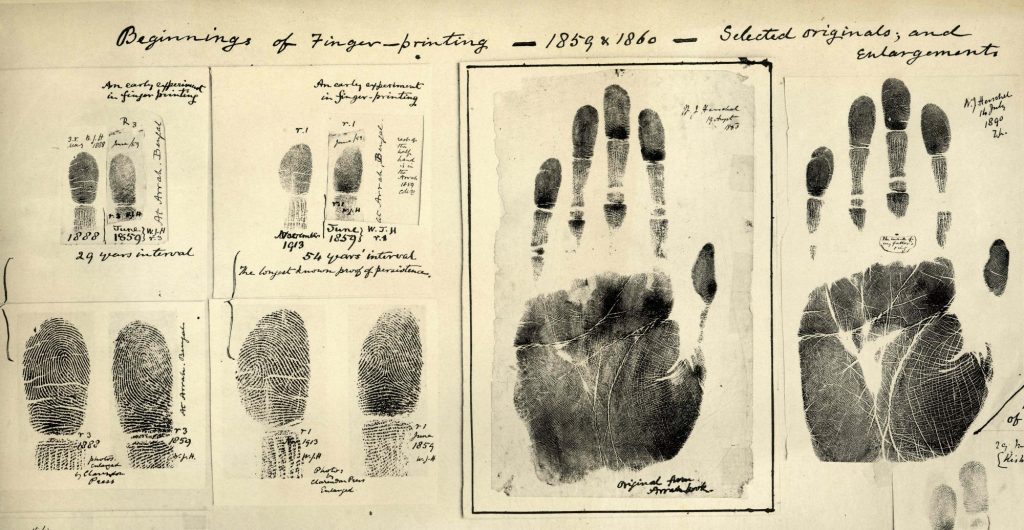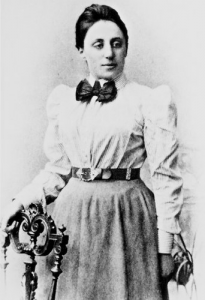After midnight, on the morning of September 19, 1910, Clarence Halsted was awakened by a man entering his ground-floor bedroom window on Church Street in the Englewood section of Chicago. The intruder was seated on the windowsill and lit a match. Mr. Halsted rose from his bed and tried to grab the intruder, but the intruder went back out the window and fled, but Mr. Halsted caught hold of the man’s coat pocket, tearing it. At 2.00 a.m. the same night, someone entered the McNabb house, which was around the corner from Mr. Halsted’s house. The man, described as “tall, broad shouldered, and very dark,” approached Mrs. McNabb’s bed and put his hand under her clothes against her bare body.1 The intruder fled down the stairs after Mrs. McNabb pushed his hand away and cried out. A few minutes later, the Hiller Family also discovered an intruder in their house when he was seen in fifteen-year-old Clarice Hiller’s room. Clarice Hiller was awakened by a man holding a lighted match in her bedroom doorway. Then he entered the thirteen-year-old Florence’s bedroom and pushed up her nightgown and touched her bare body. He left the room and came face to face with the girls’ father, Clarence Hiller. The two men grappled and rolled down the stairs. When they reached the bottom, the intruder pulled out a gun and shot Mr. Hiller once in the neck and once in the chest, killing him almost instantly.2
Cases like these have been crucial to the need of forensic science to aid in crime scene investigation. Forensic science has been in the process of development, advancing in technology and techniques over the years. However, the most innovative technique that became the turning point in Forensic Science was the development of fingerprint identification. A murder case in South London, known as The Farrow Case, which happened in 1905, was the first case ever to use fingerprint analysis to aid in identifying a criminal in court.3 In consequence, there was a case in the United States that was able to use fingerprint evidence in court for the first time. This case was the Clarence Hiller Case, People v. Jennings. These two cases are related because the United States needed help to identify the fingerprint evidence in the murder of Clarence Hiller, and Scotland Yard was their best bet in recovering the evidence left at the scene of the crime.

Before fingerprint evidence became the new way of identifying a criminal, there was a system called the Bertillon System, created by a man named Alphonse Bertillon. Alphonse Bertillon, born in 1853, was a rebellious man who tried a variety of careers before his family’s influence secured a position for him with the Prefecture of the Paris Police on March 15, 1879. It was at this time that Bertillon began taking measurements of certain bony portions of the body, among them the skull width, foot length, cubit, trunk and left middle finger. These measurements, along with hair color, eye color, and front and side view photographs, were recorded on cardboard forms measuring six and a half inches tall by five and a half inches wide. This process became known as the Bertillon System. Standardization of the Bertillon System throughout the civilized world meant that, for the first time in recorded history, any individual, once properly classified, could be positively identified later.4

Courtesy of Wikimedia Commons
The benefit to police agencies was incalculable. However, claims that this system would deplete the ranks of the professional criminals were somewhat overly-optimistic and premature. Bertillon devised a method to document and study the victim’s body and circumstances of death. Using a camera on a high tripod, lens facing the ground, a police photographer made top-down views of the crime scene to record all the details in the immediate vicinity of a victim’s body. Early in the twentieth century, police departments began to use Bertillon’s method to photograph murder scenes.5 Bertillon died on Feb. 13, 1914, in Paris. His anthropometric method of identifying recidivists represented a first step toward scientific criminology. It is said that his work played an important role in inspiring greater confidence in police authorities and in establishing a more favorable sense of justice toward the end of the nineteenth century.6 In 1903, the Bertillon System took a bad turn when it was used on the Will West Case. A reporter named Don Whitehead said, “It was this incident that caused the Bertillon System to fall flat on its face.”7

On May 1, 1903, an African American man named Will West entered the United States Penitentiary at Leavenworth. West was subjected to the standard admission procedure: prison clerks took photographs, a physical description, and eleven anthropometric measurements. When taking West’s measurements and description, identification clerks matched him to the record of another William West, who had a previous conviction for murder. Not surprisingly, through the clerks’ view, West denied that he was this man. The discovery of Will West’s past conviction must have seemed routine in the Leavenworth clerks’ view: once again, the world-famous Bertillon System of identification had prevented a criminal from escaping his past. The incident suddenly deviated from the usual, however, when the clerks discovered to their amazement that this same William West was already incarcerated at Leavenworth. The second West was summoned, and he looked startlingly like the first. Their faith in anthropometry shaken, the clerks fingerprinted the two men, and their fingerprints were completely different. 8
As the Bertillon System began to decline, the use of fingerprints in identifying and classifying individuals began to rise. After 1903, many prison systems began to use fingerprints as the primary way to identify a suspect.9 Bertillon measurements are difficult to take with uniform exactness, and physical dimensions can change as a result of growth or surgery. For these reasons, fingerprinting and other methods have, for the most part, superseded the Bertillon system as the principal means of identification in American and European police systems.10
Thomas Jennings, an ex-convict, a Negro “laboring man,” was apprehended three-quarters of a mile from the Hillers’ house thirteen minutes after the shooting by four off-duty police officers who, unaware of the murder, saw blood on his shirt and found a .38 caliber revolver in his pocket.11 The revolver contained cartridges which matched those found at the crime scene of Mr. Hiller, and residue of gunshots of recent firing, Jennings’ coat pocket was torn in a manner consistent with that described by Halsted, and he had fresh cuts that may have been defensive wounds. Jennings contended that he had torn his coat at work, had injured his hand by falling off a streetcar, and had never fired his revolver. Neither of the witnesses saw the intruder’s face in the dark; they were only able to describe his build and said he was a colored man. Clarence Halsted, Mrs. McNabb, and her daughter Jessie testified that Jennings looked like the man that broke into their houses that night. The three break-ins plus the murder case were found to be connected since they all were in the same area and the times matched from Jennings starting with Halsted’s house after about 1:30 a.m., then going to Mrs. McNabb’s house at about 2 a.m. and shortly after 2 a.m. Jennings was at the Hiller’s home. Additionally, the first two break-ins had similar descriptions and Clarence Hiller murderer was already identified after the police saw Jennings plus the blood and gun that had residue. In a matter reminiscent of the West case, the Chicago Police Department called in its fingerprint examiners to individualize a “colored” man, whom witnesses could not identify except to say that he was colored.12 William Evans worked for his father Michael Evans at the Chicago Police Department’s Bureau of Identification and he found finger impressions in the recently dried paint on Hiller’s porch railing, and he matched the prints to inked prints taken from Jennings.
Fingerprinting was new enough to warrant an extended debate over its validity as a forensic technique in the trial. Five fingerprint examiners testified as expert witnesses: Michael and William Evans; another Evans son, Edward, formerly of the Bureau of identification, who had taken prints from Jennings upon earlier arrest; Edward Foster, chief of the Bureau of Identification of the Canada Dominion Police; and Mary Holland, head of the U.S. Navy Bureau of Identification. All five had been trained in the fingerprint identification by Detective John Ferrier of Scotland Yard at the St. Louis World’s Fair. Foster and Holland testified that they had subsequently traveled to London for further instruction and they had passed proficiency tests at the Yard.13 All five of them agreed that the print found in the paint of the porch railing matched Jennings’ print. Foster testified that he had never seen two fingerprints with ridge characteristics so “exactly alike.”14 He portrayed the identity of the two prints as a matter of fact rather than interpretation.
At Jennings’ May 1911 trial, there were two Chicago Police Department fingerprint examiners, a fingerprint technician from the police department in Ottawa, Canada, and a private expert who had studied fingerprint science at Scotland Yard in Victoria, London, who testified that the impressions on the porch rail matched the ridges on four of the defendant’s fingers, placing him at the scene of the murder. While fingerprints had been around for about twenty years, this was the first U.S. jury to be presented with this form of impression evidence. The chance of convicting Jennings was difficult due to the defendant’s arrest one mile from the house, his injuries, his possession of a recently fired gun, and his murder scene fingerprints, all being circumstantial evidence. In those days, and to some extent today, jurors prefer direct evidence in the form of confessions and eyewitness identifications.15
Thomas Jennings went to trial charged with the murder of Clarence Hiller. Thomas’ lawyer insisted that the fingerprint evidence was not recognized by the laws of Illinois and shouldn’t be admissible in court. However, the judge disagreed and allowed the evidence, Jennings was subsequently convicted of the murder of Clarence Hiller, and sentenced to death. This was good news for forensic science, and bad news for Thomas Jennings, who died in 1912 at the end of a rope.16
In order to understand the modern-day importance of fingerprint evidence in the United States legal system, one must be familiar with important early legal cases. One such case is People v. Jennings (1911).17 People v. Jennings laid the groundwork for forensic fingerprint identification in America. By 1925, virtually every court in the United States accepted this form of impression evidence as proof of guilt. In medicine, illness leads to cures, and in law enforcement, murders produce advances in forensic science.18
- Simon A. Cole, Suspect Identifies: A History of Fingerprinting and Criminal Identification (Cambridge, MA: Harvard University Press, 2001), 177. ↵
- Simon A. Cole, Suspect Identifies: A History of Fingerprinting and Criminal Identification (Cambridge, MA: Harvard University Press, 2001), 178. ↵
- “Fingerprint Evidence Is Used to Solve a British Murder Case,” History.com (blog). November 13, 2009. https://www.history.com/this-day-in-history/fingerprint-evidence-is-used-to-solve-a-british-murder-case. ↵
- “Identification Systems in New York State: The Bertillon System,” NYS Division of Criminal Services, (1997). ↵
- “Visible Proofs: Forensic Views of the Body: Galleries: Technologies: The Bertillon System.” U.S. National Library of Medicine, June 05, 2014. https://www.nlm.nih.gov/visibleproofs/galleries/technologies/bertillon.html. ↵
- In Encyclopedia of World Biography 2004, s.v. “Alphonse Bertillon.” ↵
- David Love, “For Black People, Fingerprinting Is a Double-Edged Sword, Sweeping Up the Innocent,” Atlanta Black Star (website), April 10, 2016. https://atlantablackstar.com/2016/04/10/for-black-people-fingerprinting-is-a-double-edged-sword-sweeping-up-the-innocent/ ↵
- Simon A. Cole, Suspect Identifies: A History of Fingerprinting and Criminal Identification (Cambridge, MA: Harvard University Press, 2001), 140-145. ↵
- “History of Fingerprints,” Crime Scene Forensics, LLC, 2015. http://www.crimescene-forensics.com/Crime_Scene_Forensics/History_of_Fingerprints.html ↵
- Funk & Wagnalls New World Encyclopedia, January 1, 2018, s.v. “Bertillon System.” ↵
- Simon A. Cole, Suspect Identifies: A History of Fingerprinting and Criminal Identification (Cambridge, MA: Harvard University Press, 2001), 178. ↵
- Simon A. Cole, Suspect Identifies: A History of Fingerprinting and Criminal Identification (Cambridge, MA: Harvard University Press, 2001), 178. ↵
- Simon A. Cole, Suspect Identifies: A History of Fingerprinting and Criminal Identification (Cambridge, MA: Harvard University Press, 2001), 178-179. ↵
- Simon A. Cole, Suspect Identifies: A History of Fingerprinting and Criminal Identification (Cambridge, MA: Harvard University Press, 2001), 179. ↵
- Jim Fisher, “The Historic Fingerprint: The Jennings Murder Case,” Jim Fisher True Crime (blog), January 01, 1970. http://jimfishertruecrime.blogspot.com/2012/03/historic-fingerprint-jennings-case.html. ↵
- Jim Fisher, “The Historic Fingerprint: The Jennings Murder Case,” Jim Fisher True Crime (blog), January 01, 1970. http://jimfishertruecrime.blogspot.com/2012/03/historic-fingerprint-jennings-case.html. ↵
- Mark A. Acree, “People v. Jennings: A significant case for fingerprint science in America,” Journal of Forensic Identification, (Jul/Aug 1999): 455. ↵
- Jim Fisher, “The Historic Fingerprint: The Jennings Murder Case,” Jim Fisher True Crime (blog), January 01, 1970. http://jimfishertruecrime.blogspot.com/2012/03/historic-fingerprint-jennings-case.html. ↵



78 comments
Emmanuel Diaz
Enjoyed the information and the history as to how we transitioned from simple photos and measurements of a human to identify, to their mere finger print would suffice enough to recognize again if necessary. Its shocking to see what caused the Bertillon system to be seen as non effective after the specific incident that could have had a one in a one million chance of happening. Its fascinating how the the techniques helped further the technology and the future of forensic science. I don’t believe there would be many situations like that of the two Will West’s but it is much more safe to be sure than to be sorry. Great article!
James Disrud
I had never heard of this story and was quickly intrigued. I enjoyed reading this article learning a lot of new things in the process.The Bertillion system was interesting to learn about, I enjoyed finding more about the evolution of fingerprinting how it came about and the processes they used, the fact that there’s millions of different fingerprints makes it a difficult task. This was a very well written and good at grabbing your attention.
James Disrud
I had never heard of this story and was quickly intrigued. I enjoyed reading this article learning a lot of new things in the process.The Bertillion system was interesting to learn about, I enjoyed finding more about the evolution of fingerprinting how it came about and the processes they used, the fact that there’s millions of different fingerprints makes it a difficult task. This was a very well written article and I enjoyed reading.
Gabriel Lopez
It’s interesting to learn that fingerprint identification was developed this early in time. It was also nice to learn about the Bertillon system and to look at the picture demonstrating it. However, I can’t imagine how coincidental it would be to find that there are two Will Wests that look almost exactly the same and have the same name. I’m glad that Jennings was caught, and that we made fingerprinting a reliable form of identification. Interesting article.
Nelly Perez
The beginning of the first paragraph had me hooked. The Britellion system was interesting except it declined after a few cases. With the Wests almost being the same, it was clear to see that the fingerprint method had to be done. Since then, detectives have been identifying the criminal with their fingerprints left on the evidence. I didn’t know that was how the fingerprint method would be made.
Azucena Cuevas
I had never heard about the origins of the fingerprint system for forensic science. It is such a good method and reading about how it came to be is interesting. With such little forensic technology they were able to recognize the difference in fingerprints in every human. The Bertillon system on the other hand was something that was easily going to fail, because some people have similar body structures but what sets them apart is their fingerprint and DNA.
Jose Maria Llano Aranalde
I really like reading all this crime stories and cases. It was interesting to see where the beginning of the use of finger prints came from. It was also really interesting to see the different processes that they used in older times. It shows you how far we have come in this field and how much technology has helped us solve passed and will help us solve future crimes.
Zoe Peña
I really enjoyed reading this article, I was not aware of the Bertillon system and it was interesting to read about it as well as how fingerprinting came into being used as evidence in crimes like these. Looking at the photos of the two Will Wests, the two look very similar and had they not been fingerprinted i would have thought that they were the same person.
Briley Perkins
I thought this article was very interesting to read, because I did not know anything about the Bertillon System. It is really cool how technology of crime scenes has changed into finding criminals. I know fingerprints are almost a common thing used in cases nowadays, but I never took a step back to think where they originated from.
Pablo Ruiz
I find this article very interesting because i did not even know about the Bertillon System. Today fingerprinting is the standard and i always thought that was how it was. The fact that it took until Will West to discontinue the use of the old system is shocking to me because it seems obvious that one can lose/gain weight and many other things to change their appearance. Luckily, today we have refined the use of Finger printing and it is undoubtedly the best way to identify criminals and not convict the wrong people.